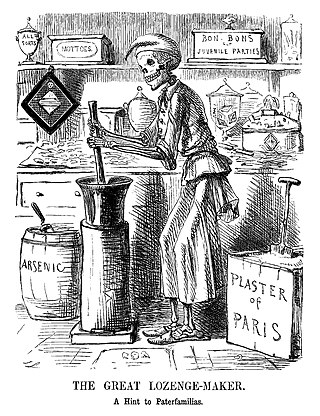
The Pure Food and Drug Act of 1906, also known as Dr. Wiley's Law, was the first of a series of significant consumer protection laws which was enacted by Congress in the 20th century and led to the creation of the Food and Drug Administration. Its main purpose was to ban foreign and interstate traffic in adulterated or mislabeled food and drug products, and it directed the U.S. Bureau of Chemistry to inspect products and refer offenders to prosecutors. It required that active ingredients be placed on the label of a drug's packaging and that drugs could not fall below purity levels established by the United States Pharmacopeia or the National Formulary.

Harvey Washington Wiley was an American chemist who advocated successfully for the passage of the landmark Pure Food and Drug Act of 1906 and subsequently worked at the Good Housekeeping Institute laboratories. He was the first commissioner of the United States Food and Drug Administration.

Food coloring, or color additive, is any dye, pigment, or substance that imparts color when it is added to food or drink. They can be supplied as liquids, powders, gels, or pastes. Food coloring is used in both commercial food production and domestic cooking. Food colorants are also used in a variety of non-food applications, including cosmetics, pharmaceuticals, home craft projects, and medical devices. Colorings may be natural or artificial/synthetic.

Zeebrugge is a village on the coast of Belgium and a subdivision of Bruges, for which it is the modern port. Zeebrugge serves as both the international port of Bruges-Zeebrugge and a seafront resort with hotels, cafés, a marina and a beach.

The legal system of Singapore is based on the English common law system. Major areas of law – particularly administrative law, contract law, equity and trust law, property law and tort law – are largely judge-made, though certain aspects have now been modified to some extent by statutes. However, other areas of law, such as criminal law, company law and family law, are almost completely statutory in nature.
An adulterant is caused by the act of adulteration, a practice of secretly mixing a substance with another. Typical substances that are adulterated include but are not limited to food, cosmetics, pharmaceuticals, fuel, or other chemicals, that compromise the safety or effectiveness of the said substance.

The Federal Insecticide, Fungicide, and Rodenticide Act (FIFRA) is a United States federal law that set up the basic U.S. system of pesticide regulation to protect applicators, consumers, and the environment. It is administered and regulated by the United States Environmental Protection Agency (EPA) and the appropriate environmental agencies of the respective states. FIFRA has undergone several important amendments since its inception. A significant revision in 1972 by the Federal Environmental Pesticide Control Act (FEPCA) and several others have expanded EPA's present authority to oversee the sales and use of pesticides with emphasis on the preservation of human health and protection of the environment by "(1) strengthening the registration process by shifting the burden of proof to the chemical manufacturer, (2) enforcing compliance against banned and unregistered products, and (3) promulgating the regulatory framework missing from the original law".

Food safety is used as a scientific method/discipline describing handling, preparation, and storage of food in ways that prevent foodborne illness. The occurrence of two or more cases of a similar illness resulting from the ingestion of a common food is known as a food-borne disease outbreak. This includes a number of routines that should be followed to avoid potential health hazards. In this way, food safety often overlaps with food defense to prevent harm to consumers. The tracks within this line of thought are safety between industry and the market and then between the market and the consumer. In considering industry-to-market practices, food safety considerations include the origins of food including the practices relating to food labeling, food hygiene, food additives and pesticide residues, as well as policies on biotechnology and food and guidelines for the management of governmental import and export inspection and certification systems for foods. In considering market-to-consumer practices, the usual thought is that food ought to be safe in the market and the concern is safe delivery and preparation of the food for the consumer. Food safety, nutrition and food security are closely related. Unhealthy food creates a cycle of disease and malnutrition that affects infants and adults as well.

There are three general sources of Singapore law: legislation, judicial precedents, and custom.

The 1858 Bradford sweets poisoning was the arsenic poisoning of more than 200 people in Bradford, England, when sweets accidentally made with arsenic were sold from a market stall. Twenty-one victims died as a result. The event contributed to the passage of the Pharmacy Act 1868 in the United Kingdom and legislation regulating the adulteration of foodstuffs.

The law of the British Virgin Islands is a combination of common law and statute, and is based heavily upon English law.

The law of Gibraltar is a combination of common law and statute, and is based heavily upon English law.

The regulation of food and dietary supplements by the U.S. Food and Drug Administration is a process governed by various statutes enacted by the United States Congress and interpreted by the U.S. Food and Drug Administration ("FDA"). Pursuant to the Federal Food, Drug, and Cosmetic Act and accompanying legislation, the FDA has authority to oversee the quality of substances sold as food in the United States, and to monitor claims made in the labeling about both the composition and the health benefits of foods.
The history of early food regulation in the United States started with the 1906 Pure Food and Drug Act, when the United States federal government began to intervene in the food and drug businesses. When that bill proved ineffective, the administration of President Franklin D. Roosevelt revised it into the Federal Food, Drug and Cosmetic Act of 1937. This has set the stage for further government intervention in the food, drug and agricultural markets.
A milk quota or dairy produce quota was a historical measure used by the United Kingdom government to intervene in agriculture. Originally introduced to reflect the agricultural policies of the European Economic Community, the quota's purpose was to bring rising milk production under control. Milk quotas were attached to land holdings and represented a cap on the amount of milk that a farmer could sell every year without paying a levy. Milk quotas were assets and could be bought and sold or acquired or lost by other means and so there was a market for them.
The Indian Slavery Act, 1843, also known as Act V of 1843, was an act passed in British India under East India Company rule, which outlawed many economic transactions associated with slavery.

The swill milk scandal was a major adulterated food scandal in the state of New York in the 1850s. The New York Times reported an estimate that in one year 8,000 infants died from swill milk.
Haddon Storey is a former politician from Victoria, Australia.

The Essential Commodities Reserves Act 1938 is an Act of the Parliament of the United Kingdom. It was passed in anticipation of the Second World War and allowed the Board of Trade to build up stockpiles of commodities considered to be essential, specifically foodstuffs, animal feed, fertiliser and petroleum products as well as the raw resources needed to manufacture these products. They paid traders at least £13.5 million to stockpile materials in the following year and a half. The act was largely superseded by the Emergency Powers (Defence) Act 1939 and the establishment, in the same year, of the Ministry of Supply. The stockpiles and associated funding were wound up by 1947 and the act has not been made use of since. It was proposed for repeal by the Law Commission in 2015.













